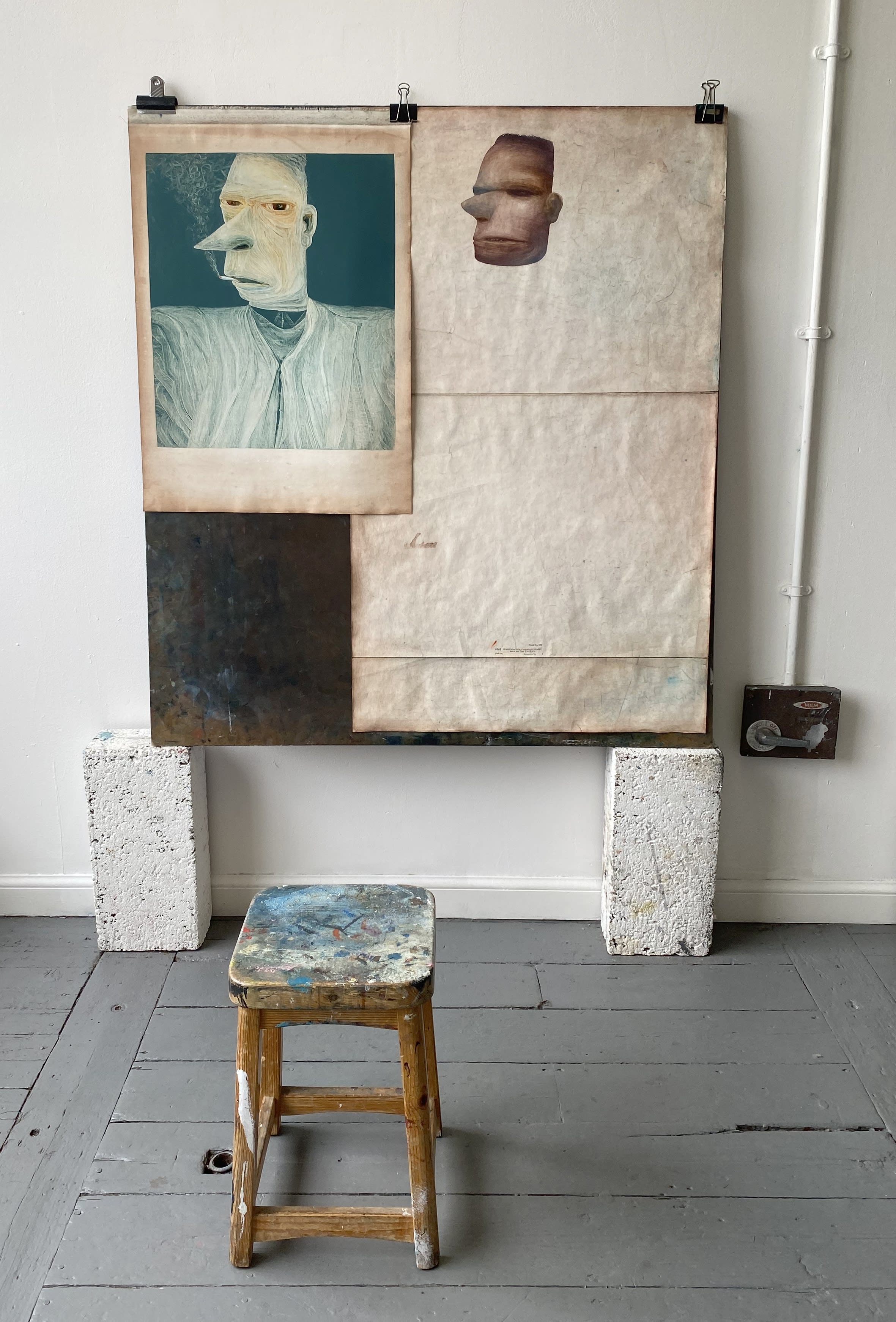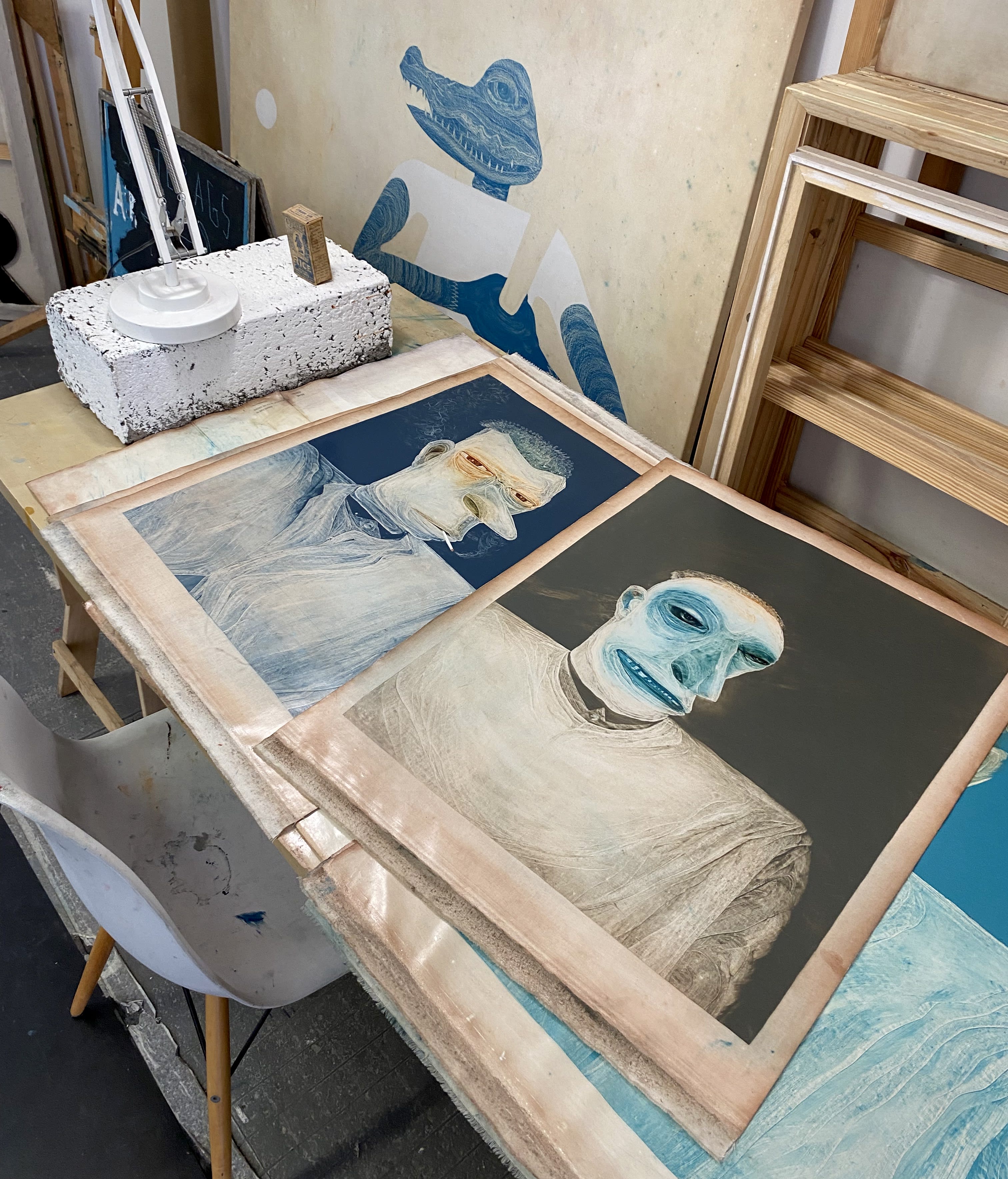RHODES is exited to introduce Stewart Swan, Glasgow-based visual artist and designer, who attempts to portray the spirit of everyday faces through suggested narrative and the profound impact of body language and human expression through his drawings and mixed media paintings. In the interview with RHODES, Swan shares insights into his style, technique, and influences.

RHODES: Please can you tell us a little about your practice, and how you have developed your artistic style?
SWAN: My practice revolves around creating imaginative and symbolic paintings that depict people, animals, and occasionally anthropomorphic beings. These artworks are influenced by my personal experiences and memories.
Throughout my artistic development, I have dedicated myself to exploring various materials and techniques, constantly experimenting to refine my unique style.
I consider myself more of a draughtsman than a painter, drawing has always come naturally to me. It serves as a powerful tool for expressing ideas and themes quickly due to its immediate nature. Drawing allows me to swiftly and spontaneously transfer my thoughts onto a surface. However, I aspired to transcend the limitations of drawing tools like charcoal, oil sticks, and pastels. I wanted to incorporate paint into my artistic process, hoping it would elevate my work in terms of scale and ambition. It was akin to transitioning from black and white film to vibrant technicolor movies.
During an extended period, particularly throughout lockdown, I embarked on a period of experimentation. I delved into a wide variety of paints, mediums, primers, and surfaces, all in search of a technique that would enable me to achieve the linear qualities of drawing through the medium of paint.

R: How does Glasgow itself influence your works?
S: Living in Glasgow has had a profound impact on my career and particularly as a portrait painter. The city's social and industrial heritage serves as a constant source of inspiration for me. While there are pockets of gentrification, much of Glasgow still retains its old charm, especially in the East End where I am based. The gritty underbelly and strong sense of community in this area are particularly captivating.
One of the things that sets Glasgow apart is its wonderful sense of humour. The city is renowned for its dry, tongue-in-cheek wit, and it doesn't take itself too seriously. This humour often finds its way into my artwork, influencing the themes I explore. I draw inspiration from the people and characters I encounter on a daily basis. Their expressions, turns of phrase, and the overall atmosphere of the city all find their way onto my canvases.
I have a habit of remembering faces, and sometimes these faces reappear in my paintings. However, they are often exaggerated or combined with other individuals to create a heightened version or caricature. I absorb the sights and sounds of Glasgow, from the old industrial chimneys to the red brick warehouses and factories. Even the city's perceived dangerous reputation at times finds its way into my work, reflecting the underlying tension that can be felt.
The slogan "People make Glasgow" perfectly encapsulates the essence of the city. The diverse and vibrant individuals who call Glasgow home are what make it such a special place. The perfect habitat for a portrait painter like myself.

R: There are a lot of animal motifs in your works, why dogs and crocodiles?
S: Dogs are a common sight in my work as well Egyptian deities such as Horus, Anubis and Ammit, yet it is the latter that often captures my imagination, and they are frequently anthropomorphized. Subconsciously, I find myself trying to depict animalistic traits in the characters I paint, particularly those resembling werewolves. At one point, I delved into the realms of cryptozoology and folklore, exploring the concept of lycanthropy, the delusion of transforming into a wolf. Interestingly, I noticed a connection between this phenomenon and gangs. Gangs, much like wolf packs, embody a primal nature, with their territorial behavior and predatory instincts. It was not just the gangs themselves that intrigued me, but also their relationship to the concept of pack hunting.
These dangerous creatures, both the gangs and the animals, pose a risk, with the former often wielding knives, which can be seen as symbols representing perceived masculinity. Werewolves, in this context, could serve as a metaphor or stylistic choice to convey the intimidation and presentation associated with gangs. However, these ideas are not meticulously planned; rather, they emerge as spontaneous acts of mark making, driven by an aesthetic motivation. The texture of animal hair and skin fascinated me from an artistic standpoint, as I sought to capture these elements in a painterly manner.

R: Your works have incredibly unique textures, how do you create works with this effect?
S: I create my textures using oil paint, which possesses the quality of being slow drying. This characteristic gives me the ability to delve into the layers of paint, shaping and molding it before it solidifies, similar to a sculptor working with clay. It provides me with a window of opportunity to draw, subtract, etch, carve, scrape, and remove paint, allowing me to bring forth form and texture in my creations.
In my artistic process, I find myself resembling a sculptor more than a traditional painter. Instead of chiseling away at stone or clay, I employ the medium of paint to carve out intricate shapes and forms. I fashion my own tools from various materials such as wood, library cards, rags, and even broken canes. With these unconventional instruments, I draw into, drag and manipulate the paint to create figures and portraits.

R: Who are your biggest influences as an artist
S: Francis Bacon and Robert Rauschenberg have a massive influence on my artistic journey. Rauschenberg's ability to infuse found objects with a tangible essence captivates me, while Bacon's masterful depiction of the human form in motion and the raw emotions it evokes invigorates my creative spirit.
Moreover, I find great admiration in the graphic brilliance of Peter Blake and the illustrative genius of John Byrne. Their works possess a unique quality that resonates deeply with me.
Of course, the list of influential artists goes on and on. From the hauntingly expressive works of Bellany to the vibrant creations of Hockney, the abstract poetry of Twombly, the evocative landscapes of Eardley, and the captivating compositions of Frankenhaler, each artist has contributed to shaping my artistic perspective in their own distinct way.
RHODES will be hosting Swan's debut London solo show Early 2024. For more information please email info@rhodescontemporaryart.com or
Email to register your interest.
